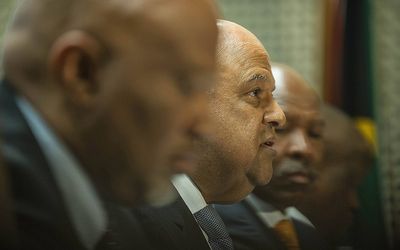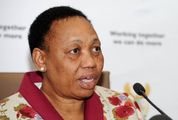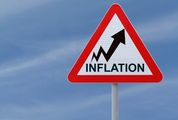THIS week is a big one for SA’s bankers. The budget speech on Wednesday will make it clear whether we can avoid a downgrade to SA’s investment rating. Five days later, Barclays is expected to announce what it plans to do with its African banking network. Both are going to be important bellwethers for our banking sector.
While predictions are a fool’s game, let me make two. I think Finance Minister Pravin Gordhan is going to be successful in his effort to placate the ratings agencies. That will happen because he will deliver believable solutions to state expenditure challenges and raising revenue. Taxes are going to go up, for the rich and the poor.
Expect value added tax hikes and a new top income tax bracket on top of increases at higher thresholds. Ideally he will be able to solve fears about the state-owned enterprises’ limitless hunger for cash by promising asset sales as the mechanism to feed them fresh equity. He will promise state hiring freezes and tough procurement oversight.
In London, Barclays has been debating the future of its African business. This is a debate that has been raging at Barclays for decades. When it purchased Absa in 2005, it was after the group decided to make a go of Africa as a marginally better option that just selling the network it had at that point.
My prediction is that it is going to come to just that conclusion again. Selling the bank is near impossible in the current market — there are no appropriate buyers anywhere in the world for a very large bank with a massive South African exposure. The Reserve Bank will insist on a shareholder of reference — one that can step in should a crisis emerge.
A big international bank or a South African company with a big balance sheet would be the only options. And those aren’t available. The best strategy for Barclays is to reduce its exposure from 62% to 50%, a move the Reserve Bank would accept as it would not amount to a change in control. Then it needs to try to sell the underperforming parts of its African network. Those are much more sellable with former Barclays CEO Bob Diamond an active buyer through his two-year-old Atlas Mara group. Assuming he can raise the funding, he’ll no doubt be an eager buyer of parts of the network.
The Africa debate is one of many issues the group is facing, with demands for it to separate its investment banking and retail business in the UK probably top of mind. Africa is a relative side show, with 14% of the group’s assets and, thanks largely to the weak rand, poor returns.
But for Africa, the support of the UK giant is important. Barclays can raise funds at lower prices because of the backing of its UK parent. If it abandons the ship, its subsidiary will see its cost of funding increase. While you may think this implies that more home-grown banks would become more competitive as a result, that’s not how banking systems work. The best-capitalised, best-funded bank sets the bar in a market. Risk-averse investors can flock to it, while others with more risk appetite can diversify between the best funded and the worst. Because of the portfolio effects, those investors are content to take the risk of including less stable banks in their portfolios. Take out the best funded, and those portfolio effects are lost, leaving investors demanding higher returns than before.
Barclays’ decision is likely to be announced with its annual results on March 1. That starts off the reporting season for the banks, with Nedbank following on March 2 and Standard Bank on March 3. FirstRand reports interims on March 8. Those are going to be interesting.
Whatever Mr Gordhan announces will become the critical factor in the banks’ outlooks for their operations.
Barclays’ announcements will also occupy the minds, if not the public monologues, of its competitors.
Mr Gordhan is delivering the single most important budget speech we’ve seen at least since 1999 when we survived the emerging markets crisis.
The bizarre sequence of events that led to his appointment, what the Treasury insiders dubbed "9/12", alluding to the 9/11 terror attacks, has made it vital that he use the opportunity to prove that the Treasury has its hand on the government’s spending tiller.
While I don’t expect the word "privatisation" to get much air time, you can be sure that terms like "rationalisation" and "equity raising from the private sector" will. That is the only credible solution to the state-owned enterprises problem. "Rationalisation" is code for disposing of assets. It is a credible strategy because it achieves two important things: raises new capital without having to turn to the taxpayer, and shrinks them, rendering them less capable of generating financial disasters.
Eskom and SAA, the two biggest headaches, will have to be addressed directly. At least in CEO Brian Molefe, Mr Gordhan has a decent counterpart at Eskom, far from the case at SAA which stands head and shoulders above the others as a disaster site. All the senior managers are in acting roles. Unfortunately there is only one, Mr Molefe, who seems capable of managing the politicians.
Eskom is becoming easier to deal with thanks to the independent power producers’ programme, which is set to add 13,225MW of renewable energy to the grid by 2020, plus another 10,000MW from other sources, compared to Eskom’s current installed capacity of 44,000MW. Eskom will become just one of SA’s power producers.
It has never been easier to sell off parts of its ageing generating fleet to other independents. SAA, unfortunately, has no easy solutions on the table.
The best is to flog it quickly to whoever is brave enough for the challenge.

Finance Minister Pravin Gordhan attends Monday's press conference in Pretoria. Picture: AFP PHOTO/MUJAHID SAFODIEN
THIS week is a big one for SA’s bankers. The budget speech on Wednesday will make it clear whether we can avoid a downgrade to SA’s investment rating. Five days later, Barclays is expected to announce what it plans to do with its African banking network. Both are going to be important bellwethers for our banking sector.
While predictions are a fool’s game, let me make two. I think Finance Minister Pravin Gordhan is going to be successful in his effort to placate the ratings agencies. That will happen because he will deliver believable solutions to state expenditure challenges and raising revenue. Taxes are going to go up, for the rich and the poor.
Expect value added tax hikes and a new top income tax bracket on top of increases at higher thresholds. Ideally he will be able to solve fears about the state-owned enterprises’ limitless hunger for cash by promising asset sales as the mechanism to feed them fresh equity. He will promise state hiring freezes and tough procurement oversight.
In London, Barclays has been debating the future of its African business. This is a debate that has been raging at Barclays for decades. When it purchased Absa in 2005, it was after the group decided to make a go of Africa as a marginally better option that just selling the network it had at that point.
My prediction is that it is going to come to just that conclusion again. Selling the bank is near impossible in the current market — there are no appropriate buyers anywhere in the world for a very large bank with a massive South African exposure. The Reserve Bank will insist on a shareholder of reference — one that can step in should a crisis emerge.
A big international bank or a South African company with a big balance sheet would be the only options. And those aren’t available. The best strategy for Barclays is to reduce its exposure from 62% to 50%, a move the Reserve Bank would accept as it would not amount to a change in control. Then it needs to try to sell the underperforming parts of its African network. Those are much more sellable with former Barclays CEO Bob Diamond an active buyer through his two-year-old Atlas Mara group. Assuming he can raise the funding, he’ll no doubt be an eager buyer of parts of the network.
The Africa debate is one of many issues the group is facing, with demands for it to separate its investment banking and retail business in the UK probably top of mind. Africa is a relative side show, with 14% of the group’s assets and, thanks largely to the weak rand, poor returns.
But for Africa, the support of the UK giant is important. Barclays can raise funds at lower prices because of the backing of its UK parent. If it abandons the ship, its subsidiary will see its cost of funding increase. While you may think this implies that more home-grown banks would become more competitive as a result, that’s not how banking systems work. The best-capitalised, best-funded bank sets the bar in a market. Risk-averse investors can flock to it, while others with more risk appetite can diversify between the best funded and the worst. Because of the portfolio effects, those investors are content to take the risk of including less stable banks in their portfolios. Take out the best funded, and those portfolio effects are lost, leaving investors demanding higher returns than before.
Barclays’ decision is likely to be announced with its annual results on March 1. That starts off the reporting season for the banks, with Nedbank following on March 2 and Standard Bank on March 3. FirstRand reports interims on March 8. Those are going to be interesting.
Whatever Mr Gordhan announces will become the critical factor in the banks’ outlooks for their operations.
Barclays’ announcements will also occupy the minds, if not the public monologues, of its competitors.
Mr Gordhan is delivering the single most important budget speech we’ve seen at least since 1999 when we survived the emerging markets crisis.
The bizarre sequence of events that led to his appointment, what the Treasury insiders dubbed "9/12", alluding to the 9/11 terror attacks, has made it vital that he use the opportunity to prove that the Treasury has its hand on the government’s spending tiller.
While I don’t expect the word "privatisation" to get much air time, you can be sure that terms like "rationalisation" and "equity raising from the private sector" will. That is the only credible solution to the state-owned enterprises problem. "Rationalisation" is code for disposing of assets. It is a credible strategy because it achieves two important things: raises new capital without having to turn to the taxpayer, and shrinks them, rendering them less capable of generating financial disasters.
Eskom and SAA, the two biggest headaches, will have to be addressed directly. At least in CEO Brian Molefe, Mr Gordhan has a decent counterpart at Eskom, far from the case at SAA which stands head and shoulders above the others as a disaster site. All the senior managers are in acting roles. Unfortunately there is only one, Mr Molefe, who seems capable of managing the politicians.
Eskom is becoming easier to deal with thanks to the independent power producers’ programme, which is set to add 13,225MW of renewable energy to the grid by 2020, plus another 10,000MW from other sources, compared to Eskom’s current installed capacity of 44,000MW. Eskom will become just one of SA’s power producers.
It has never been easier to sell off parts of its ageing generating fleet to other independents. SAA, unfortunately, has no easy solutions on the table.
The best is to flog it quickly to whoever is brave enough for the challenge.





















Change: -0.47%
Change: -0.57%
Change: -1.76%
Change: -0.34%
Change: 0.02%
Data supplied by Profile Data
Change: -1.49%
Change: 0.08%
Change: -0.47%
Change: 0.00%
Change: -0.04%
Data supplied by Profile Data
Change: -0.34%
Change: 0.03%
Change: -0.10%
Change: -0.22%
Change: -0.69%
Data supplied by Profile Data
Change: -0.28%
Change: -1.15%
Change: -0.07%
Change: -1.21%
Change: -0.22%
Data supplied by Profile Data